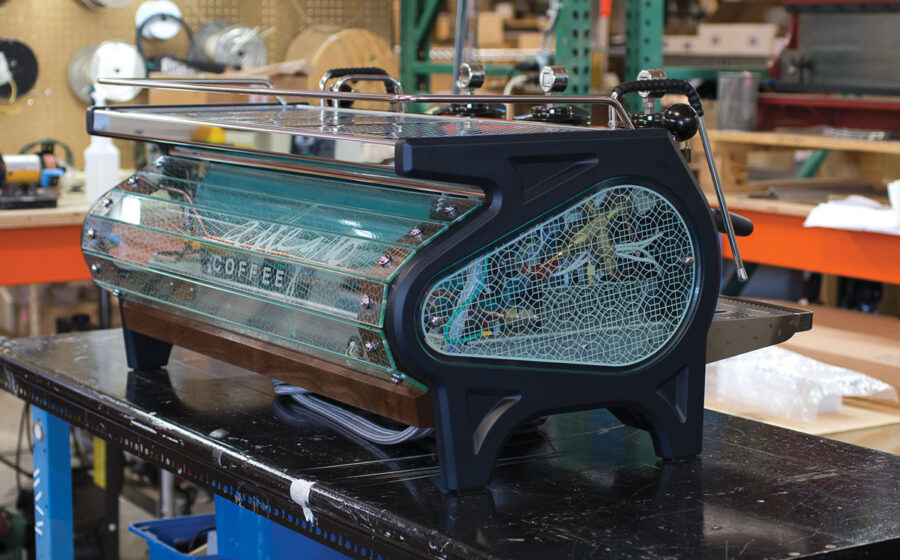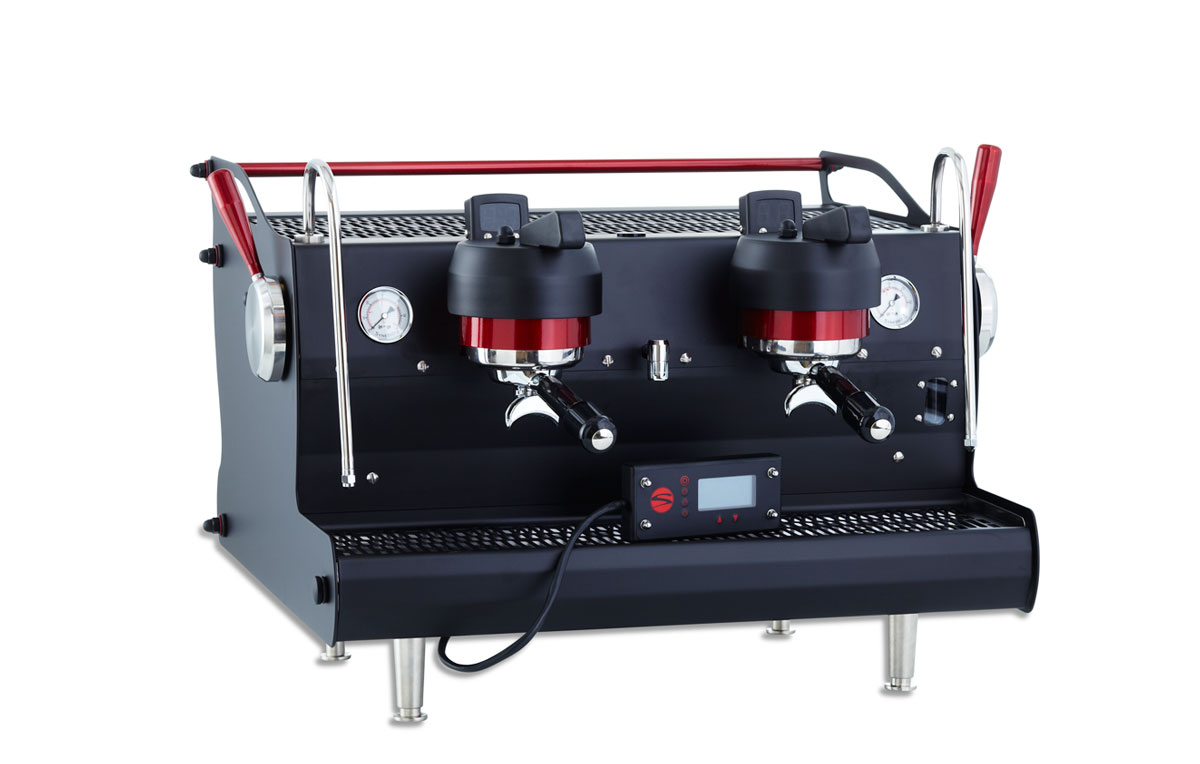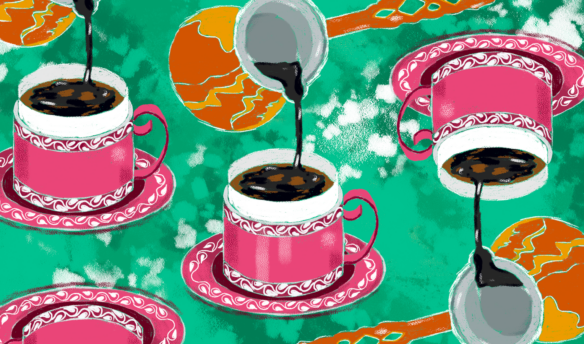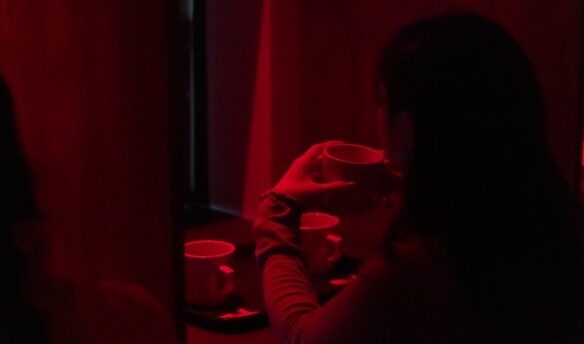[T]here’s a robust argument to be made that we’re living in a golden age of industrial design. After a few decades devoted to plastic and disposability, decades when people thought an architecture style called brutalism was a good idea, industrial design followed the same path as food and clothing and furniture and, well, really the culture at large. There are few consumer products that look worse now than ten years ago. Cars, blenders, fans, vacuum cleaners, all of Steve Jobs austere offspring. The same goes for the gear in a coffee shop. Grinders were hulks smashed into a corner lest we look at them. Those, ice machines, and refrigerators have design sense now. And of course espresso machines have slimmed down.
The decreased mass of espresso machines, allowed by a bevy of technological innovations, means that they’ve come out from behind the bar. Or, at least, the nooks and barriers that once hid the machines aren’t so common in modern build-outs. The machines, gorgeous examples of design, are displayed, nakedly, on countertops, as much a part of the bar’s design as the tile or wood wrapping the counter.
But now that more of these machines are on display, a new problem has arisen: they all kind of look the same. Without the need for a massive, most likely plastic, case, every major espresso machine maker followed a simple, elegant design sensibility that resulted in all the machines sporting low profiles, protruding group heads, and a modern-meets-art-deco look.
They’re also still among the biggest pieces of equipment in a café, causing their standard black or silver to have a solid chance of clashing with or dominating a space. Just like the iPad on a counter, they’re beautiful but the same. And just like the POS tablet that’s been ensconced in a custom case, more and more café owners are customizing the look of their machines.
[J]acob Ellul-Blake says that if he’d tried to start an espresso machine customization business ten years ago, it would never have flown. The aesthetics of café design hadn’t reached their current rarified (read: expensive) heights. Springing for a machine was expensive enough. Why splurge on a bespoke case? Maybe that’s true, but when you see Ellul-Blake’s work you doubt it.
Ellul-Blake started his coffee career at La Marzocco in 2005, working as a design engineer on their nascent GS3 project. He spent a few years there, then moved to a job building accessories for adventure motorcycles, “BMWs that people ride . . . across Siberia.” At La Marzocco, he had talked with the folks at Stumptown about customizing a machine, though it never happened. Then in 2012 Stumptown bought a pair of Strada MPs and they hired Ellul-Blake to build the cases. From the front and sides, you’d never know it was a Strada. Instead of the S-shaped case wrapping the guts on the customer side, the lower half is matte-black, and slopes down and back, while the top piece, sloping up and back, is antiqued brass with a silver mirror bolted to it. The word Stumptown is written on the mirror in gold leaf. The sides are similar, though with white oak to frame, which repeats on the paddle handles and cup rack on top. The blow-your-mind results led Ellul-Blake to start Pantechnicon late last year.
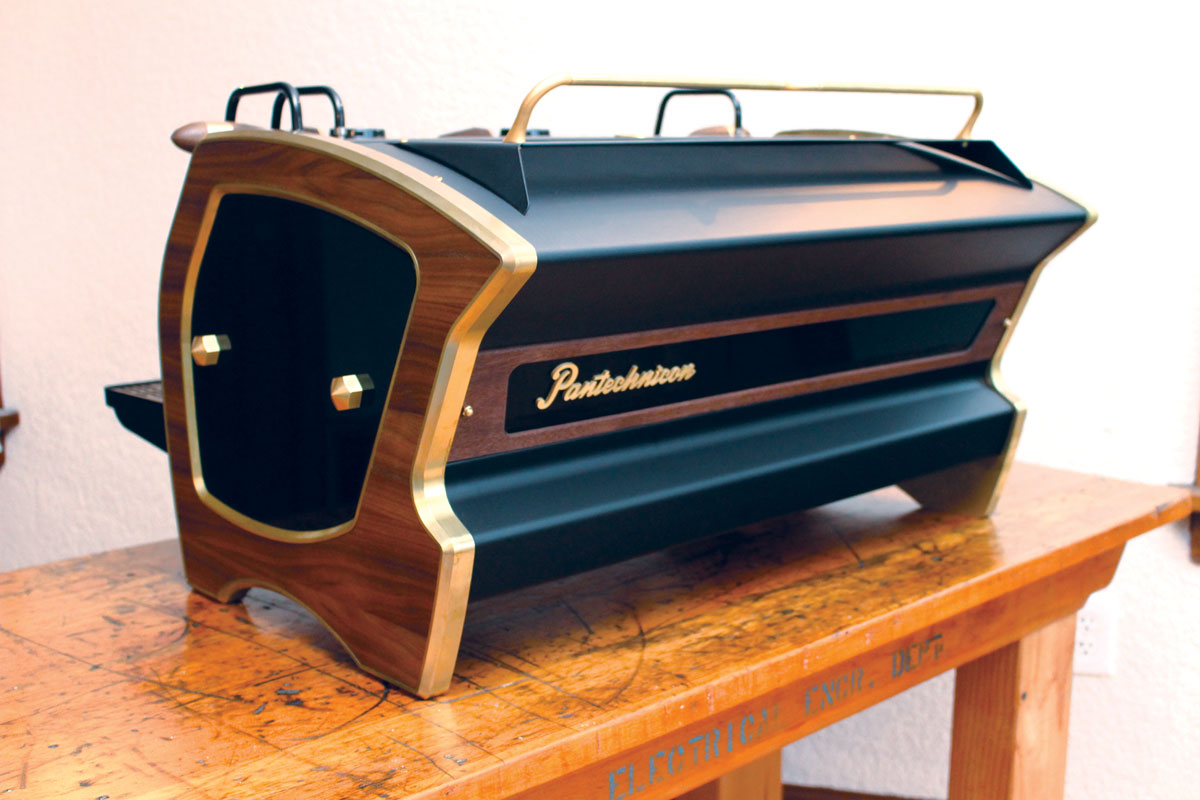
“There’s a part of it that is just the magic of seeing the machine for the first time,” he says. “People have the expectation that it’s an appliance. Most people don’t have an expectation that it’s going to be anything different from the stainless steel box they’ve seen a hundred times before. If you surprise somebody and show them something that is unique and really engaging and beautiful and has all these different materials and finishes that they haven’t seen before in anything, let alone an espresso machine, I think it captures part of their imagination. That creates a really powerful experience.”
Scrolling through Espresso Parts’ Flickr account is like walking through a carnival or candy store one moment and then opening a door onto a Parisian salon circa 1929, except all the clowns and poets are espresso machines.
Just a few miles down Interstate 5, David Ringwood of Espresso Parts has created one ridiculous customization after another. In 2007, he and Espresso Parts began custom work doing not just aesthetic jobs but building what Ringwood calls “Frankenstein machines.” That’s the extreme side of customization, something few people build or buy. “The person who wants that is going to have a good idea of the functionality of the machine, how they want to alter it, the overall interaction of the person with the machine,” Ringwood says. The cost is enough to scare off any pretenders. (That was echoed by Ellul-Blake, who said that performance modifications used to be common but that machines perform so much better now that the potential benefits of a modification don’t outweigh the service headaches such tinkering can cause.)
More and more, the work Ringwood does is strictly aesthetic. Scrolling through Espresso Parts’ Flickr account is like walking through a carnival or candy store one moment and then opening a door onto a Parisian salon circa 1929, except all the clowns and poets are espresso machines. Lattice backing gives one machine an effortless sophistication, while lime-green panels make another playful as a pool toy.
One recurring approach, done over and over because it succeeds so well, is to encase the machine in glass, revealing instead of hiding the circuit boards and wires and tubes. Ringwood paints the boiler, often garishly, and the result resembles the Georges Pompidou Center.
In a normal process, both Ellul-Blake and Ringwood work with a new machine and coordinate with the client to find the best design and color scheme to work with the café. Ellul-Blake even examines design documents from the architect to influence his design.
“The way I tend to think about it is creating something that’s both integrated with the rest of the design language of the space that feels really connected to the space and also is unique and stands out and is noteworthy and remarkable,” says Ellul-Blake. “Both blending in and standing out at the same time.” While more and more customers go in for massive overhauls of their new machines, the machines’ makers are offering more options from the get go. Most often, this involves powder-coat painting the case. Nuova Simonelli, La Marzocco, Slayer, and Synesso all offer this. In interviews with each of the companies, they said orders for custom machines have increased.
[S]cott Guglielmino, product manager at La Marzocco, said that three years ago, he might send out three machines every year with a custom paint job. Now it’s between fifteen and twenty percent of their orders. Synesso began offering powder-coat paint a year ago, and in their most recent month a third of their machines went out with a new color.
While customizations to the inner workings of the machines aren’t normal, they aren’t impossible. Ben Brown at Nuova Simonelli says common changes will be to flow rates and pre-infusion temperatures. “These changes get them into different ballparks,” he says, going well beyond the adjustments normally available. Synesso, which offers four wood options for their machines’ paddles and handles, built a six-headed Hydra for Australian coffeehouse Proud Mary. A rep at Synesso said Aussies, in particular, love custom machines.
Slayer’s machines were designed with customization front of mind. A recent machine they touted heavily on social media was made for Ström Coffee in Richland, Washington. The café is housed in a spit-shined classic Airstream trailer and the espresso machine, with an over-polished and over-riveted case, matches it perfectly. Another machine has stitched leather on the sides.
That level of bespoke work is rare for any manufacturer, and probably not a path other companies will run down. Most likely coffee is seeing the birth of yet another profession within its expanding scope. Not many people do what David Ringwood and Jacob Ellul-Blake can, but more and more probably will.
—Cory Eldridge is Fresh Cup’s editor.



